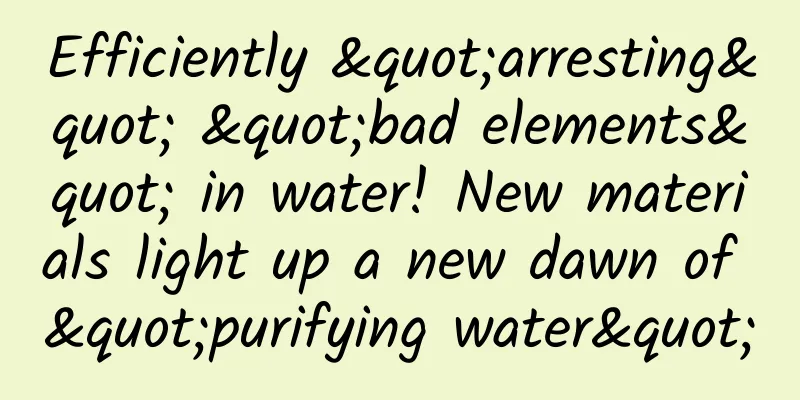Efficiently "arresting" "bad elements" in water! New materials light up a new dawn of "purifying water"

|
Author: Huang Xianghong Duan Yuechu In today's society, with the rapid development of industry and the increasing frequency of human activities, the problem of water pollution has become increasingly serious. The presence of toxic heavy metal ions in water poses a serious threat to the ecological environment and human health. However, an exciting scientific breakthrough may bring new hope for solving this problem. Copyright images in the gallery. Reprinting and using them may lead to copyright disputes. An international research team involving Kyoto University in Japan recently announced their important research results in the journal Nature Communications on August 13, 2024 - the successful development of a new type of polymer material, which can selectively capture large amounts of toxic heavy metal ions in water, showing great potential for purifying the water environment. At present, the water purification materials we are familiar with often have some difficult-to-overcome limitations when dealing with heavy metal ion pollution in water. Traditional water purification methods mainly rely on the small pores in the material to adsorb ions, or to achieve the purpose of purifying water by exchanging ions in the material with ions in water. However, these methods usually have difficulty in achieving both removal efficiency and selective removal of target ions. This means that in the actual water purification process, it may not be possible to efficiently remove specific heavy metal ions that are extremely harmful to the human body and the environment, or some beneficial ions may be removed together during the removal process, thereby affecting the water purification effect and the quality of water resources. However, some plants and animals in nature have provided valuable inspiration for researchers. For example, when plants face heavy metal ions such as cadmium contained in groundwater, they use plant chelates in their cells to selectively capture these harmful ions and seal them into vacuoles, thereby protecting themselves from the toxicity of heavy metal ions. Inspired by this, researchers carefully designed a synthetic polymer. The uniqueness of this polymer is that it has the same functional groups that plant chelates use when binding to heavy metal ions. This innovative design makes it outstanding in its ability to bind to heavy metal ions, even surpassing plant chelates. In order to further improve the water purification effect of this polymer material, the research team also worked hard on the integration of the material. They successfully achieved ultra-high integration of this polymer material, which greatly improved the efficiency of capturing ions. In the purification experiment of industrial wastewater, only 3 ml of this ultra-high integrated material can remove cadmium ions in 300 ml of wastewater to meet the standards of drinking water within one hour. This amazing purification ability undoubtedly provides strong technical support for solving the problem of industrial wastewater pollution. Imagine if this new polymer material can be widely used in actual water purification projects, what kind of changes will it bring? First of all, it can more accurately remove toxic heavy metal ions in water, improve the safety of drinking water, and protect people's health. For those industrial enterprises that rely on water resources for production and development, efficient water purification technology can reduce production costs, reduce pollution to the environment, and achieve sustainable development. The research and development of this new material also provides us with new ideas and methods to deeply understand and solve the problem of water pollution. It prompts us to pay more attention to the self-protection mechanism of organisms in nature, draw inspiration from it, and develop more innovative, efficient and environmentally friendly water purification technologies and materials. At the same time, it also reminds us to pay more attention to environmental protection, reduce pollution of water resources, and reduce the difficulty and cost of water pollution control from the source in the process of pursuing economic development and scientific and technological progress. Although this new polymer material performed well in experiments, it still faces a series of challenges and problems in order to truly apply it to large-scale water environment purification projects. For example, the production cost of the material, the process and technology of large-scale production, the stability and durability of the material, etc., all require further research and optimization. In addition, for different types of industrial wastewater and natural water bodies, the adaptability and purification effect of this material also need to be tested and evaluated more extensively and in-depth. We cannot rely solely on a single water purification technology and material to solve the complex and diverse water pollution problems. While promoting this new polymer material, we also need to use a variety of water purification methods, such as physical filtration and biological treatment, to form a diversified and multi-level water environment purification system. In addition, strengthening water resource management, raising public awareness of environmental protection, and establishing sound environmental protection laws, regulations and regulatory mechanisms are also important guarantees for achieving sustainable use of water resources and effective protection of the water environment. The research and development of this new polymer material has brought new hope and possibilities to the field of water environment purification. However, to realize its maximum value in practical applications, it still requires the joint efforts of researchers, enterprises, governments and all sectors of society. I believe that in the near future, we can rely on continuous innovation of technology and the joint actions of the whole society to make water resources shine with clarity and purity again, and provide a solid guarantee for human survival and development. In the future, with the continuous advancement of science and technology and the in-depth development of research, we expect this new polymer material to be continuously improved and optimized. At the same time, we also expect more innovative water purification technologies and materials to emerge and contribute to solving the global water pollution problem. Let us work together to protect our blue planet and leave clear waters for future generations. |
<<: Shock! Is the "skin-beautifying" baby cream actually a devilish trap for your baby's health?
Recommend
Is there a limit on the number of times a Douyin ID can be modified? How many times can a Douyin ID be modified?
Everyone who uses TikTok has a TikTok ID account....
Is it not a dream to lose weight by lying down? What other information is worth paying attention to behind the "switch" for burning fat?
Everyone knows the simple principle of weight los...
China Railway Corporation has taken another step forward in its mixed-ownership reform, and has joined hands with Tencent and Geely to develop and operate a high-speed train WiFi platform
Recently, the bidding for the equity transfer of ...
This gene allows cells to “reborn with memories”!
If you were asked to be reborn in childhood with ...
Advanced ways to operate and promote Xiaohongshu!
When we mention Xiaohongshu, we may think of reco...
Summary of methods for upgrading Windows 7/8.1 to Windows 10
On July 29, 2015, Microsoft will release the offi...
Operational notes from Tencent PM: 3 major skills for product operation
Making TO C products is like playing with buildin...
4 Practical Tips for Conference Marketing
As an important part of the marketing process, co...
China Automobile Dealers Association: In the February 2025 Automobile Retention Rate Report, large models have a higher retention rate
Recently, the China Automobile Dealers Associatio...
300 JD Experience Stores point the way for the industry How will the fourth retail revolution reshape the market landscape
With the continuous improvement of technology, th...
Can sleep-aiding aromatherapy really cure insomnia? Don’t believe it anymore because…
“Sleep-aiding aromatherapy can cure insomnia.” Th...
Do cats really care about you? Now we have a conclusion
Hello, this is Science Popularization China. We o...
How to debug CSS compatibility issues in iPhone Safari browser
If our computer browser has CSS compatibility iss...
How can back-end developers feel? Salaries of front-end programmers exposed
Recently, a programmer who has worked in the back...
Which virtual host data storage rental hosting service provider should I choose?
Which virtual host data storage rental hosting se...









